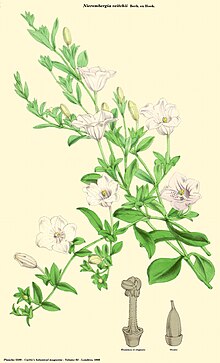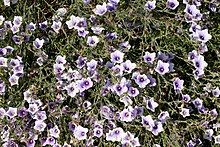White cup
| White cup | ||||||||||||
|---|---|---|---|---|---|---|---|---|---|---|---|---|

Creeping white cup ( Nierembergia repens ) |
||||||||||||
| Systematics | ||||||||||||
|
||||||||||||
| Scientific name | ||||||||||||
| Nierembergia | ||||||||||||
| Ruiz & Pav. |
The white cups ( Nierembergia ) are a genus of plants in the nightshade family (Solanaceae). Most of the 23 or so species thrive in western and southern areas of South America , with one species only found in Mexico .
description


Vegetative characteristics
The species of the genus Nierembergia are mostly upright, stooped or prostrate growing, herbaceous plants with stature heights of mostly 20 to 40 (5 to 60) cm. Occasionally they form rhizomes , which in some species have bulbous nodes . Only a few Nierembergia species are shrubs with heights of 0.2 to 2 m. The endodermis has Casparian streaks and there is no starchy sheath.
The leaves are sessile or stalked 2 to 4 mm long. The leaf blades are 8 to 65 (rarely only 3) mm in length and 0.6 to 4 (rarely 0.3 to 19) mm in width, linear, elliptical, ovoid, obovate or round.
Inflorescences and flowers
The flowers are solitary or in loose, zymose inflorescences . The flower stalks are usually 1 to 12 mm (0.2 to 21 mm) long or completely absent.
The hermaphrodite flowers are five-fold with a double flower envelope . The calyx is mostly 11 to 18 mm, rarely 8 to 34 mm long, the corolla tube is funnel-shaped or bell-shaped and traversed by ten longitudinal ribs. The elongated, triangular, egg-shaped or linear calyx lobes can be shorter or longer than the calyx tube and have three to five veins. The zygomorphic crown is plate-shaped, usually 12 to 30 mm, rarely 8 to 70 mm long. The thread-shaped corolla tube widens abruptly into a bell-, funnel- or cup-shaped coronet, which reaches a diameter of 14 to 20 mm (rarely 6 to 33 mm). The lower third of the five short and wide corolla lobes is covered with short, glandular trichomes in most species . These glandular hairs secrete oils that are of particular importance for pollination by various bees.
All five stamens are fertile, the stamens are occasionally the same length, but mostly three short and two longer stamens are formed, the latter carrying larger anthers . The stamens are slightly hairy and glandular and attach to the opening of the corolla tube. The outline of the anthers is circular (then 0.6 to 1.45 mm in diameter) or kidney-shaped (and then 0.65 to 0.8 × 0.8 to 1.2 mm in size). The counters of the dust bags stand free in their lower half. The pollen grains are relatively large at 45 to 70 µm, and their shape varies widely. They are given out individually or glued into tetrads or pollen balls. There are no nectaries . The scars are depressed in the shape of a head, lobed or crescent-shaped. In the latter case, they often enclose the anthers with the long, tapered ends.
Fruits and seeds
The capsule fruits hardly protrude beyond the calyx and contain 20 to 100 seeds. The relatively small polyhedral seeds are 0.9 to 1.9 × 0.7 to 1 × 0.7 to 0.9 mm in size. The cotyledons are slightly longer than the rest of the embryo .
Chromosome number
The chromosome number of at least 13 species was examined, the basic chromosome number was x = 8 or x = 9. Two species have different degrees of ploidy.
ingredients
In Nierembergia linariifolia , the substance pyrrole-3-carbamidine , which makes the plant toxic to cattle, sheep, goats, horses and rabbits , was first detected. Three other glycosides were found in Nierembergia rigida .


Systematics and distribution
The genus Nierembergia was established in 1794 by Hipólito Ruiz Lopez and José Antonio Pavón y Jiménez in Florae Peruvianae, et Chilensis Prodromus , page 23. The generic name Nierembergia honors the Spanish clergyman and natural historian Juan Eusebio Nieremberg (Juan Eusebio Nieremberg y Otin, 1595–1658). The type species is Nierembergia repens Ruiz et Pav .
Most species of the genus Nierembergia are distributed in western and southern areas of South America , only Nierembergia angustifolia grows exclusively in an area in Mexico that is disjoint from the rest of the distribution area . The main distribution center with 15 species is in Argentina , with Nierembergia linariifolia one species reaches northern Patagonia .
There are about 23 species in the genus Nierembergia (according to Hunziker 1995, 2001 and Ulloa et al. 2018):
- Nierembergia andina Millán : It only occurs in Bolivia .
- Nierembergia angustifolia Kunth : It occurs only in Mexico .
- Nierembergia aristata D.Don
- Nierembergia boliviana Millán : It occurs only in Bolivia.
- Nierembergia browallioides Griseb.
- Nierembergia calycina Hook.
- Nierembergia ericoides Miers
- Nierembergia espinosae Steyerm. : It occurs only in Ecuador .
- Nierembergia graveolens A. St.-Hil.
- Nierembergia hatschbachii A.A. Cocucci & Hunz. : It wasfirst describedin 1993 from Brazil .
- Narrow-leaved white cup ( Nierembergia linariifolia Grah. )
- Nierembergia micrantha Cabrera
- Nierembergia pinifolia Miers
- Nierembergia pulchella Miers : It is common in Bolivia and in the southern part of South America.
- Creeping white cup ( Nierembergia repens Ruiz et Pav. ): It occurs in Uruguay , Chile , Argentina , Colombia , Ecuador and Peru .
- Nierembergia rigida Miers
- Nierembergia riograndensis Hunz. & AACocucci : It was first described in 1993 from Brazil.
- Nierembergia rivularis Miers : It is distributed from Bolivia and Brazil to the southern part of South America.
- Shrub white cup ( Nierembergia scoparia Sendtn. )
- Nierembergia spathulata Kunth : It occurs only in Bolivia.
- Nierembergia tandilensis (Kuntze) Cabrera
- Nierembergia tucumanensis Millan
- Nierembergia veitchii Hook. : It occurs in Brazil and Argentina.
use
The species Nierembergia linariifolia , Nierembergia repens and Nierembergia scoparia and possibly one or two other species are used as ornamental plants .
proof
literature
- Armando T. Hunziker: The Genera of Solanaceae. ARG Gantner Verlag KG, Ruggell, Liechtenstein 2001, ISBN 3-904144-77-4 .
Individual evidence
- ↑ a b Nierembergia at Tropicos.org. In: IPCN Chromosome Reports . Missouri Botanical Garden, St. Louis
- ↑ a b Nierembergia at Tropicos.org. Missouri Botanical Garden, St. Louis, Retrieved November 27, 2018.
- ↑ Lotte Burkhardt: Directory of eponymous plant names. Extended Edition. Botanic Garden and Botanical Museum Berlin, Free University Berlin Berlin 2018. [1]
- ↑ Armando T. Hunziker: 256. Solanaceae. Pt. 1, subtribe VII b. Nierembergiinae . In: Flora fanerogamica Argentina , Fasc. 1st December 1995. Pages 2-16.
- ↑ Armando T. Hunziker: The Genera of Solanaceae. ARG Gantner Verlag KG, Ruggell, Liechtenstein 2001, ISBN 3-904144-77-4 .
- ↑ a b c d e f g h i j C. Ulloa Ulloa et al., 2018; Vascular Plants of the Americas = VPA. Nierembergia at Tropicos.org. In: 83 . Missouri Botanical Garden, St. Louis
- ^ A b Nierembergia in the Germplasm Resources Information Network (GRIN), USDA , ARS , National Genetic Resources Program. National Germplasm Resources Laboratory, Beltsville, Maryland. Retrieved November 30, 2017.